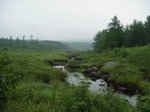Years ago, as a newlywed, I began baking bread. The urge to do so was one part economy, three parts embracing my inner hausfrau and two parts connection with my grandmother. Throughout my childhood, I cannot recall ever seeing store bought bread in my grandmother's home. I can still remember the unique scent of her bread drawer, can still see in my mind the drawer lined with paper bags and filled with partial loaves of simple bread and wheels of lightly glazed cinnamon rolls.
All through my childhood, my mother baked, and I always stood near, watching and learning. For many years, Saturday meant the smell of cinnamon rolls rising on the warm dryer while the laundry spun dry. I learned from her just how to knead doughs, how to gauge the temperature of the water and many other bread baking techniques, but the one thing I never remember her doing was forming the dough she created into a loaf of bread. Perhaps she did only make sweet doughs. I should ask her someday. So I began my bread baking career with my grandmother's recipe for bread, my mother's technique for kneading and Betty Crocker's method of handling the dough and shaping.
I have baked on and off for years since those first forays. As a busy new mom, the bread machine was the cat's meow. Toss in a few ingredients and a couple of hours later, voila warm bread. The luster faded quickly though, and it fell to the wayside once my gleaming white Kitchen Aid stand mixer appeared on the scene. Machine-made bread never had the same flavor or texture as loaves that I formed and baked myself. I branched out from my grandmother's recipe to new ones from friends, and occasionally baked free-form loaves on my stones.
This fall, I got the courage to start a batch of sourdough starter, and my bread baking changed forever. I am not sure why sourdough took so much courage to begin, but now that I finally am working with it and gaining confidence with it, I have a renewed love of all things bread. If I can create sourdough starter and keep it alive, I can learn how to form baguettes the proper way and form pan loaves in a manner that Betty never covered. I can explore the art of traditional breads from other cultures. I can experiment with pumpernickel and whole grains. I can make croissants. (My first attempt at those should be ready late morning tomorrow. Stop by for a sample and a latte if you are near.)
I have invested in good cookbooks on breads and have been talking with other experienced home bakers. I especially love the ideas covered in Local Breads, the ancient traditions involved in using sourdough starters (levains, bigas, whatever language you want to use to describe the essential mix of flour, water and wild yeast) to create an endless variety of bread.
Bread to me is like a new year or new day dawning. The basic recipe for a leavened loaf is always the same - flour, water, a little yeast, simplicity itself. Bakers around the world and throughout the centuries have taken those simple ingredients and created from them an stunning variety of breads. Vary the flours, the amounts of water, the types of yeast, the fermentation time, the shaping and you have completely changed the character of the finished bread. If that isn't enough, toss in some other ingredients, accent the bread with seeds, nuts, cheeses, herbs, anything. Keep it simple, make it complex, the possibilities are endless.
There is a magic in the rising strands of gluten, a faith that something unseen acting in a way that I cannot fully explain will soon become something wonderful. For me, it is a reminder of the mysteries, the magic, the wonder of life.
~~~~~~~~~~~~~~~~~~~
I would love to share recipes, but do not want to infringe upon copyright. So, I will share the only recipe that I can, the recipe that began my passion for breads, my grandmother's recipe. She never actually measured, but my mother took a day off from work nearly three decades ago to sit with grandma while she baked, measuring each item that grandma pulled out to put into her bread. I am thankful she did because to my tongue, this bread still tastes like my grandmother's house. It is a simple white bread, nothing fancy, but a part of my heritage nonetheless and my simple contribution to the bread baking world.
4 c hot water
2-3 tsp salt
1 Tbsp sugar
2 Tbsp lard (I have used shortening, but the taste with lard is different. I usually use the lard like my grandmother did)
1 1/2 pkg dry active yeast (I usually use about 1.5 Tbsp)
Mix the above. Add flour to absorb the liquid. Let stand for 10 minutes. Add flour until firm. Knead. Let rise once or twice (depending on time, it does do fine with a single rise). Form into loaves and let rise. Bake at 350 degrees for 45 minutes. This makes 4 loaves, but it can be halved to make two loaves.
Wednesday, February 06, 2008
Posted by
Brenda
at
9:41 PM
![]()
Subscribe to:
Post Comments (Atom)







No comments:
Post a Comment